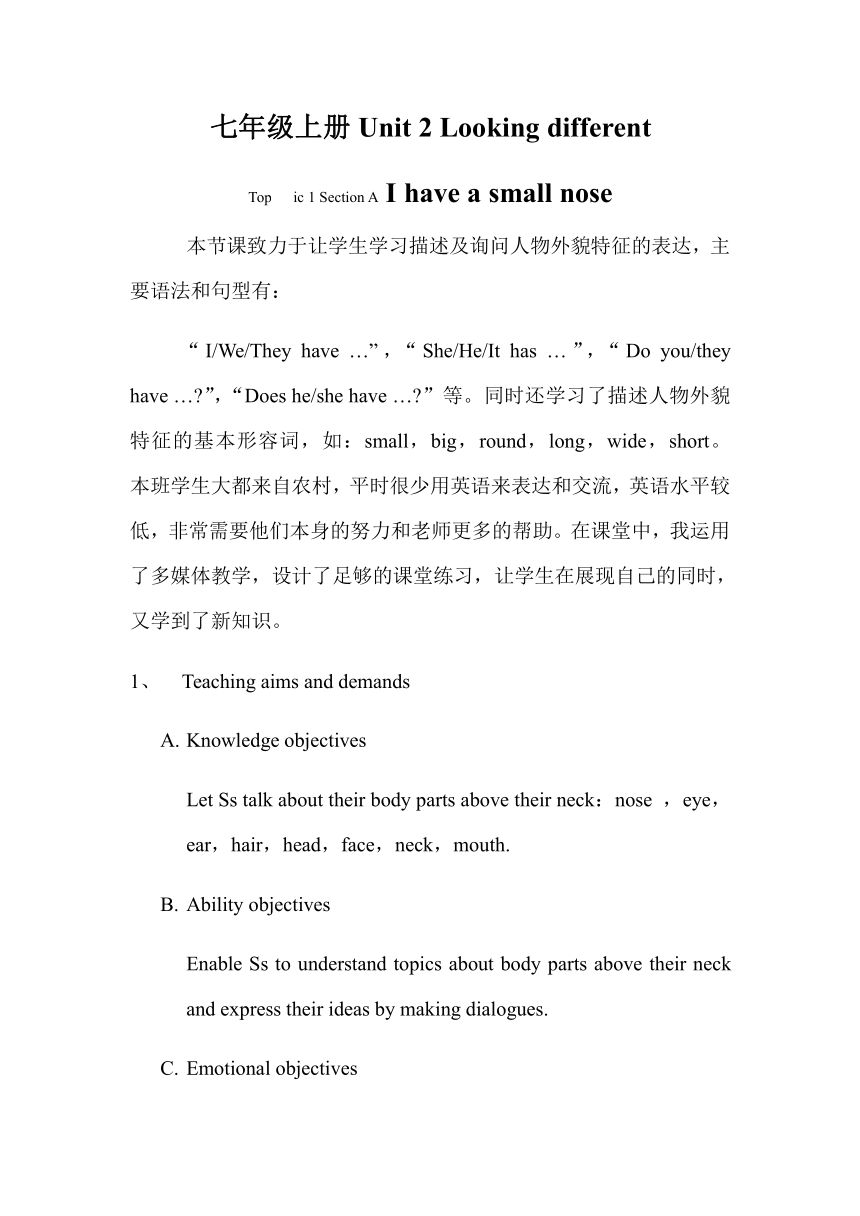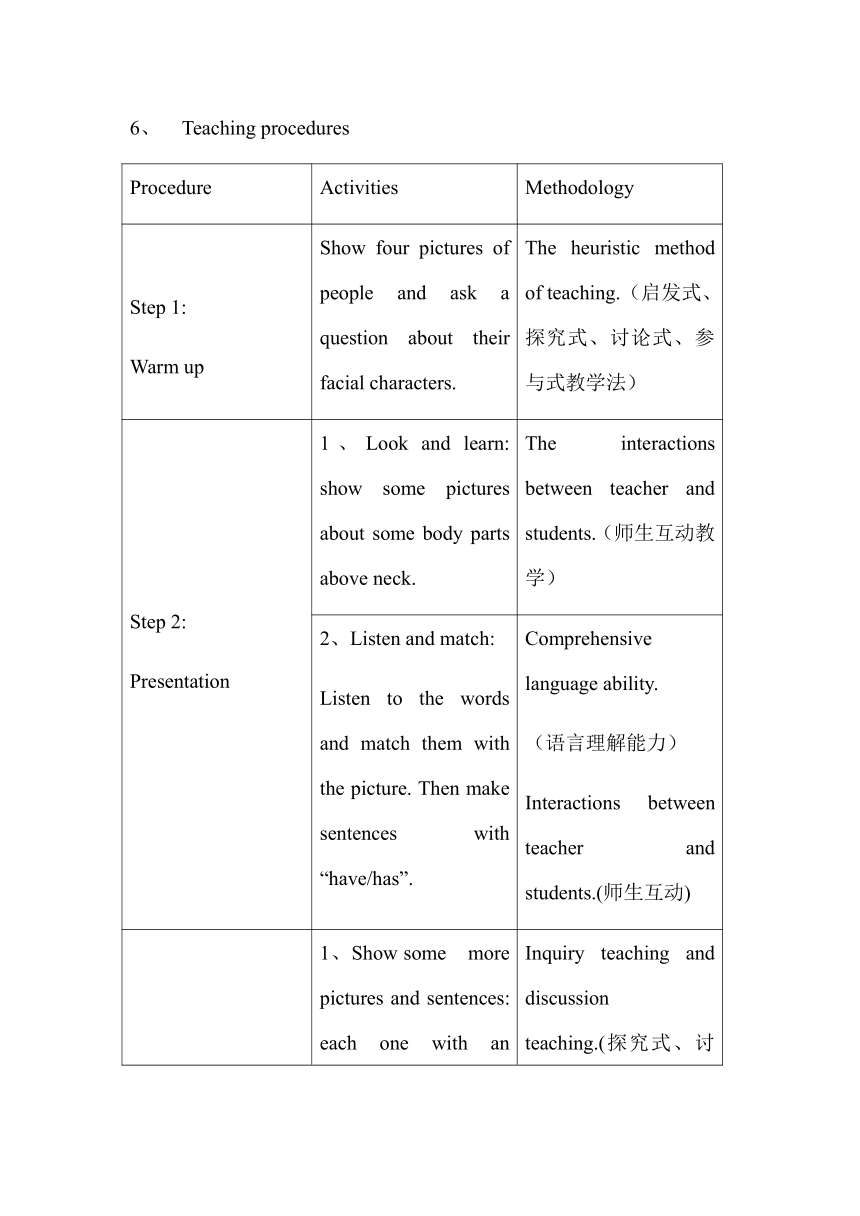Unit 2 Looking different Topic 1 I have a small nose. 教案
文档属性
| 名称 | Unit 2 Looking different Topic 1 I have a small nose. 教案 |  | |
| 格式 | zip | ||
| 文件大小 | 28.0KB | ||
| 资源类型 | 教案 | ||
| 版本资源 | 仁爱科普版 | ||
| 科目 | 英语 | ||
| 更新时间 | 2019-12-05 20:30:10 | ||
图片预览



文档简介
七年级上册Unit 2 Looking different
Topic 1 Section A I have a small nose
本节课致力于让学生学习描述及询问人物外貌特征的表达,主要语法和句型有:
“I/We/They have …”,“She/He/It has …”,“Do you/they have …?”,“Does he/she have …?”等。同时还学习了描述人物外貌特征的基本形容词,如:small,big,round,long,wide,short。 本班学生大都来自农村,平时很少用英语来表达和交流,英语水平较低,非常需要他们本身的努力和老师更多的帮助。在课堂中,我运用了多媒体教学,设计了足够的课堂练习,让学生在展现自己的同时,又学到了新知识。
1、 Teaching aims and demands
A. Knowledge objectives
Let Ss talk about their body parts above their neck:nose ,eye,ear,hair,head,face,neck,mouth.
B. Ability objectives
Enable Ss to understand topics about body parts above their neck and express their ideas by making dialogues.
C. Emotional objectives
Develop their large interest, optimistic character and active attitude to life and future.
2、 Teaching important points
Learn countable nouns and uncountable nouns.
Learn the formation of countable nouns, add –s and –es.
Learn the following sentence patterns: “I have ….”, “She/He has”, “Do you have …” to describe and ask people’s appearance characters.
3、 Teaching difficult point
How to teach Ss to describe and ask people’s appearance characters.
4、 Teaching aids
Multimedia and a blackboard.
5、 Blackboard Design
6、 Teaching procedures
Procedure Activities Methodology
Step 1: Warm up Show four pictures of people and ask a question about their facial characters. The heuristic method of teaching.(启发式、探究式、讨论式、参与式教学法)
Step 2:Presentation 1、Look and learn: show some pictures about some body parts above neck. The interactions between teacher and students.(师生互动教学)
2、Listen and match:Listen to the words and match them with the picture. Then make sentences with “have/has”. Comprehensive language ability.(语言理解能力)Interactions between teacher and students.(师生互动)
Step 3:Practice 1、Show some more pictures and sentences: each one with an adjective. Inquiry teaching and discussion teaching.(探究式、讨论式教学)
2 、Present some more interesting pictures and sentences with blanks for students to fill with adjectives. Learning practice. Learning participation. Learning cooperation. (学会练习、参与、合作)
Step 4: Consolidation Look at the blackboard: use have/has and facial characters to make sentences. Task-based teaching method.(任务型语言教学)
Step 5:Homework Review words and expressions of facial character and use them to describe yourself. Concern the development of main body and personality of students.(关注学生的主体性和个性化发展)
这节课经过本人的精心设计,在实际教学中取得了重大的成功,也受到学生的广泛喜爱,但它也有值得改进的地方,以下是我对这节课的反思:
第一,在本节课的练习和巩固阶段,学生出现了“He/She have a small nose.”这样的语法错误。作为老师的我一听就忍不住要立刻去纠正这种低级的错误,却不知道学生的自尊心经不起我这样一次又一次直接的打击。他们开始变得有所顾忌,不敢主动的举手回答问题,害怕再犯同样的错误而被老师批评和被同学嘲笑。
那么,如何在课堂上纠正学生的语法错误而又不影响他们的学习主动性和积极性呢?
经过和同事探讨,发现他们在平时的教学当中也遇到了同样的困扰,所谓三个臭皮匠顶个诸葛亮,功夫不负有心人,我们最后想到了一个两全齐美的办法:引入小组竞赛。通过小组竞赛这一简单的方法,将学生的注意力转移到比赛上去,既充分地调动了学生学习的积极性,又让同学在不失面子的情况下纠正了语法错误。
第二,还是在本节课的练习和巩固阶段,让学生使用have/has来描述自己和身边同学时,由于一些先天性的生理特征,让有些同学成为别人的笑柄,比如:有的同学很调皮,他在说“He has a small eyes.”时,会接着用汉语说他“鼠目寸光”。还有一个学生说完“She has long hair.”后,又加上一句“头发长见识短!”当场引起全班女生的不满。这些情况的出现真的是我始料未及的,当时我只是利用教师的威严和快速转移话题的方法一带而过,如果没有很好的课堂驾驭能力,就很容易导致课堂失去控制。
其实,课后经过反思我认为我们完全可以借此机会将三维目标落实到课堂中,既解决了眼前的问题又能引导他们树立积极正确的人生观。具体我们可以这样处理:当学生说“鼠目寸光”时,老师可以接着说:目光敏锐呀!当学生说“头发长见识短!”时,老师可以接着说:人不可貌相,海水不可斗量,我们不能以貌取人!教育学生事物都有两面性,引导学生形成对生活和未来的积极态度。
Topic 1 Section A
I have a small nose
头: head 单数: He has …
大眼睛:big eyes She has …
小鼻子:a small nose It has …
长脖子:a long neck 第一人称:I have …
短头发:short hair 复数: We have …
大嘴:a wide mouth You have …
圆脸:a round face They have …
同课章节目录
- Unit 1 Making new friends
- Topic 1 Welcome to China!
- Topic 2 Where are you from?
- Topic 3 How old are you?
- Unit 2 Looking different
- Topic 1 I have a small nose
- Topic 2 What does she look like?
- Topic 3 Whose jacket is this?
- Unit 3 Getting togethe
- Topic 1 Does he speak Chinese?
- Topic 2 What do your parents do?
- Topic 3 What would you like to drink?
- Unit 4 Having fun
- Topic 1 What can I do for you?
- Topic 2 Would you like to cook with us?
- Topic 3 What time is it now?
